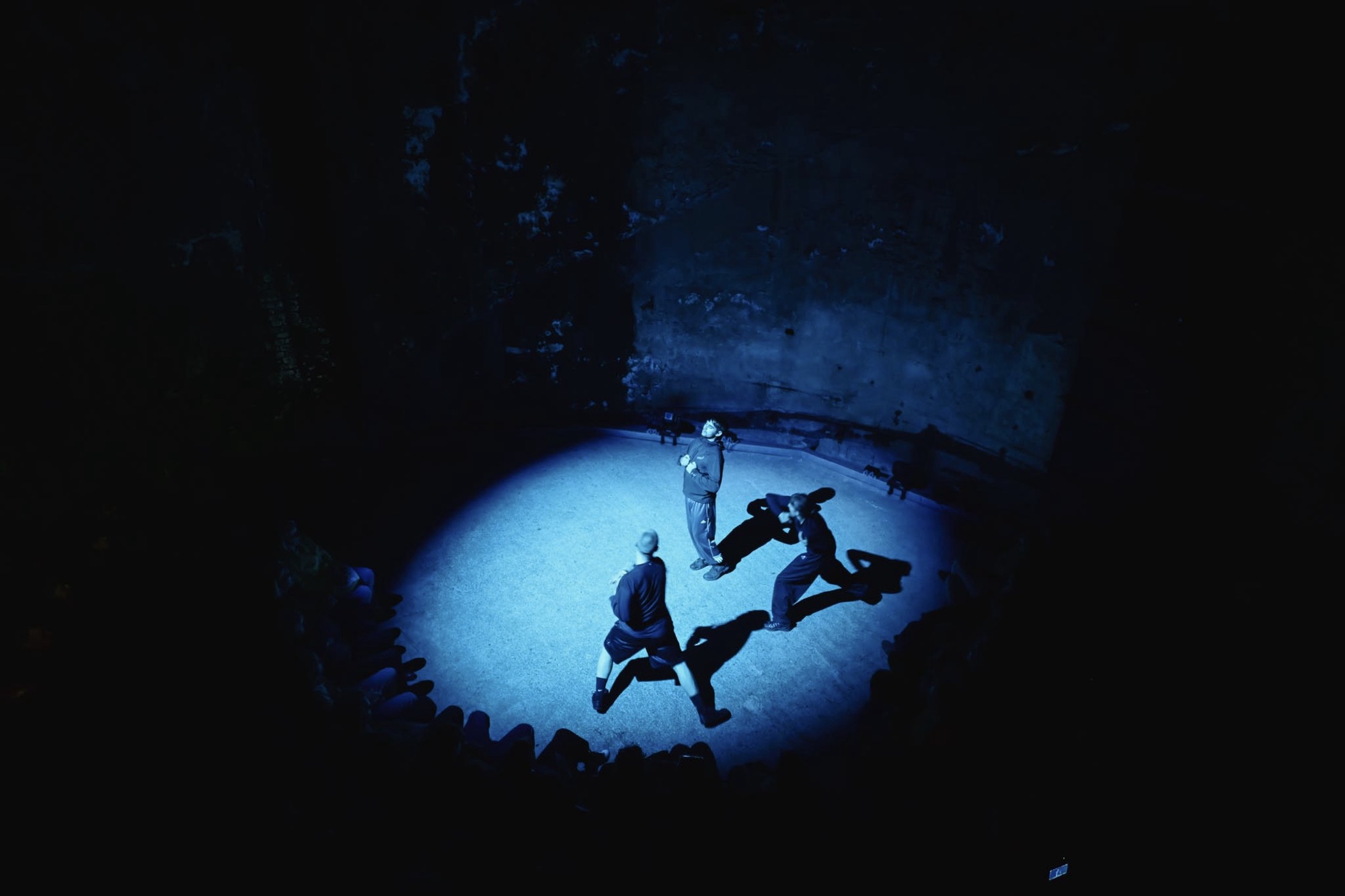Words by Florence Nicholls.
This month, as part of the Thames Festival, Samara Langham presented the double bill SKYE ZONE Burial and angels’ mumble at the Brunel Museum, tucked away in Rotherhithe along the Thames Path. The evening was a treasure trove of hidden gems, from the withheld sensitivity of Langham’s works to the lesser visited venue that held them, echoing the traces of Isambard Brunel’s legacy from within the Rotherhithe sinking shaft.
Both works took on the colliding materialities of the location; as tough and barricading as concrete. As shadowy and deep as the Thames.
SKYE ZONE Burial opened with a pool of blue light and a dancer that seemed to walk on water. Moving forward they stepped their feet, performing a variation of a backslide, creating the illusion they were hovering above ground or suspended in water. This stepping motif appeared in several sections of the dance, becoming a ritual for the trio. These moments seemed to signify a grounding, coming back to their centres to breathe and regain strength.
Wrists, necks and shoulders were strained, gripped and curled, expressing deep sensory tension whilst their lower bodies carried a weighty softness that allowed the trio to perform striking shifts through space. I felt a resonance with Botis Seva’s choreographic inflection in Langam’s motifs. Equal measures of tautness and groove. Then, swinging into release, the trio let loose in their own qualities, constructed by Langham’s keen eye for expressive improvisation. All the while in SKYE ZONE Burial, the trio rode a soft current that flowed from the hips and shoulders in the form of gentle undulations. Again, this action appeared like a ritual within the piece not simply due the motifs repetition but by the ease at which it was performed. These moments bonded the trio in a natural state of being.
Something concealed, contracting below the skin, I felt the shivers of kinesthetic empathy when tight, contorting gestures released into flow state. I unclenched my jaw and took a sigh of relief in response to expansive sequences, impactful swipes and vast scooping movements that extended beyond their physical extremities.
SKYE ZONE Burial ended in calm monotony, like treading water. Under intensifying blue light, the energy dissipated, turned into repetitive gestures and diminishing shapes that faded into blackness.
In angels’ mumble, an arrow of light cut through the concrete floor. Accompanied by a combination of recorded and live sound, four dances explored a supple relationship with space, moulding to their surroundings in order to push away and find clarity in solo. Half-lit and arranged in a jagged line, the four found a wide second position and performed a signature move of Langham’s: Round, rhythmic undulations. Mustered from the core, this repetitive motion appeared to permeate every cell.
SKYE ZONE Burial reverberated in textural extremes: Splintered then fluid. Whereas, angels’ mumble found a continuous flow. Gestural sequences performed on demi pointe created the feeling that the dancers were suspended in midair, between the harsh ground and an endless sky. Eyes gazed above the audience towards a distant horizon.
The solo moments in angels’ mumble were captivating. One dancer seemed to overflow, coming off balance to catch themselves at the edge of a fall with impressive control. They skated across the tops of their feet and softened into buckled knees, finding gentleness and ease in an obscure physicality. The second solo was performed against the curved concrete wall of the sinking shaft. Inexplicably moved, I watched them try to peel their body away from the rough surface that pulled them in with immense gravity.
In their choreographic style, Langham exhausts the capacity of every decision, seeking to reach the depths in each movement. By relishing in repetition and extended motifs, Langham presents a confident choreographic style and lust for detail that is both satisfying and inspiring to watch, allowing the space for their collaborators’ to enrich the set movement with stylistic expression. Both works have me eager to explore Langham’s work further, excited by the prospect of their choreography reaching a larger audience on a bigger stage.
